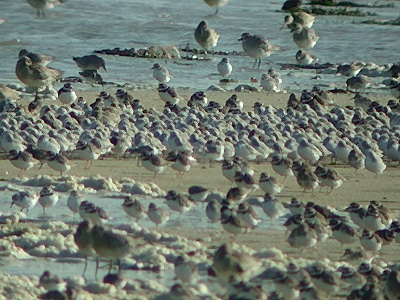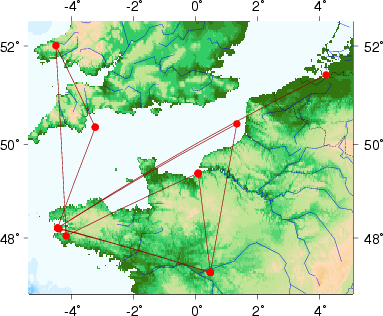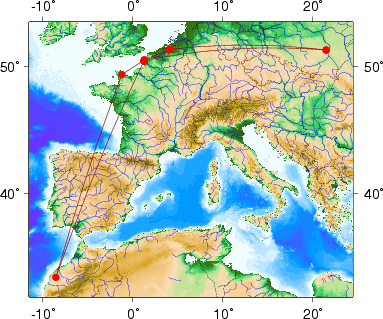|
|
|
|
|
|
|
|
 |
|
|
|
|
|
|
|
|
|
|
|
|
|
|
 |
|
|
 |
 |
| © Sylvain HOUPERT |
|
Back to the home page Access to the unofficial database of Gulls ringed by Norman Van Swelm Access to the automatic processing of Mediterranean Gulls life-histories files for Google Earth Access to the automatic processing of Sanderling life-histories files (2007- programm) for Google Earth Access to the automatic processing of Flamingos life-histories files (french & italian programs) for Google Earth Access to the automatic processing of Brants life-histories files (Alterra) for Google Earth Some examples of ringed birds paths An unknown aspect of ornithology : rings reading Birds are a very interesting research field, whenever you want to study their migrations, their behaviour, their dispersion etc. All these things lead the scientists to try to identify them as belonging to the group they study or even to identify them as an individual we can follow when it moves. The easiest method to do that is to ring them. The rings fixed on legs do not become worn easily, and it allows to follow a ringed bird for a long time. Only trained and authorized persons are empowered to ring birds because all ringing programs have to be declared. 1. Where are birds marked ? 2. How to find a ringed bird ? 3. What species ? 4. What to note ? 5. Transmit your data 6. And to finish... Where are birds marked ? Birds are mainly ringed on legs, but some of them wear a plastic piece on the wing (wingtag), others wear a collar on the neck (neckband, essentially for swans and geese), others have a plastic piece on the bill (nasal saddle, only for ducks), and finally, some of them are painted with flashing colors so that we can detect them from a long distance (colour-dyed birds). Concerning the legs rings, it exists the traditional metal ringing (aluminium, steel ...), where the ring is very small and the code is not easily readable, unless you are very close to the bird with good light condition. It also exists color ringing, where the birds, additionnaly to the metal ring, wear one or more color rings, on which code can be written. This code can identify a bird individually. If there is no code, a combination of color rings without code can also be used to identify a bird individually.
Far more technical, some birds are followed by satellite with an Argos mark (satellite-tagged birds). This is essentially the case for large birds : raptors, storks etc. How to find a ringed bird ? It is very simple, you just have to search ! Of course you have to carefully check birds legs, but without forgetting the wings. Nasal saddles and color-dyed birds are almost unmistakable. Any large birds roost (>100 birds of a same species) is very likely to contain at least one ringed bird. But there are big differences depending on the species, some of them being more ringed than others. As for the equipment, I think you have to use a field scope or to be very close to be able to read a ring with binocular. Of course, do not forget a pen and a piece of paper. Birds are usually not frightened by cars, so if you have the possibility to watch a birds flock from the car do not hesitate ! If not, try to approach them as carefully as possible, without making them fly away, since 1) it is ornithologically speaking not fair and 2) you have 0% chance to read a ring if the ringed birds disappeared ! And be tenacious, watch the birds one per one several times, it is very frequent to miss ringed birds when they are in the middle of big flocks because another bird was hiding it or simply because you did not paid attention to it the first time. Test : Find the ringed bird on this picture ! 
It is easy, isn't it :-) ? What species ? In theory almost all species can be coulour-ringed in Europe. But depending on their migratory behaviour, the places it leaves, its feeding habits and of course, the ratio of ringed birds among the whole population of the species, there are big differences ! In France and probably in all western Europe, the easiest cr-ringed species to see is the Mediterranean Gull (see below). This species settled indeed in Europe only since 80's in Western Europe (it was used to nest only around the Black Sea before) and the western population is growing quickly. That explains scientists' interest for this species. It should be a good approximation saying that 10% of the Med Gulls is cr-ringed in western Europe. In Finistère (westernmost part of France) for example (migrating and wintering place), it is common to see them on sandbeaches near rocks. It is there from September to Februar, even if some birds come sooner or leave later. The observed birds in Finistère come from Poland, Germany, Hungary, Belgium, Netherlands, France, and even Ukraine. The Mecca for this bird is in Le Portel in Pas-de-Calais (northern France, near Calais) where they gather by hundreds during July. Rings readings are extremely easy (even with binoculars) because the birds are not shy at all. It is not too hard to read more than one hundred of rings in two hours. Some of these birds flew more than 1000 km in a week ! Always along the coastline, in marshes or is some bays, keep an eye on European Spoonbills. The Spoonbills observed in Finistère come from the Netherlands, where they settled in recently, like the Med Gulls. This species is also easy to follow because it is a large bird (easily seen from a great distance, and big characters on the ring). For example, among a flock of 20 Spoonbills observed in November in the Bay of Goulven (Finistère) 4 were cr-ringed ! If you are lucky, you can observe a Spoobill which has been up to Western Africa ! Light green ringed Spoonbill (U2 on both tibias) : 
Then come all the gregarious species, like waders (sandpipers, plovers, godwits etc.) and larids (gulls, terns). These two families have the advantage to gather on open grounds and not to move (at least on resting places for waders). Along the shoreline, flocks of several hundreds of waders are the rule, and when they are quiet it can be successful to watch for rings. Concerning the wader, Dunlins, Sanderlings, Red Knots and Common-ringed Plovers seem to be the most ringed, since the probability to find one metal-ringed bird among 100 birds is very close to 100%. Up to now the only cr-ringed waders I have seen are Red Knots and Bar-tailed Godwits but others can be cr-ringed too. For larids, besides the Mediterranean Gulls, I have not the feeling that some species are more ringed than others. Among a flock of 500 (all species mixed), there is a high chance to find at least one of them ringed (color or not). I imagine it is still true for inland roosting places but I have never been able to verify. Examples of big flocks of waders at high tide particularly interesting for ring readings : 

Finally come Ducks, Swans and Geese, which often gather in big flocks. The Ducks, which are always on the water are unluckily very difficult to control if they are leg-ringed (that is why some use nasal saddles). Geese, Swans, and grazing Ducks are easier to control when they are in fields. Brent Geese for example can be very interesting because they come from very far (central Siberia, Taymir peninsula for some of them). You can take a look inland at storks, raptors (Ospreys for example), Egrets, Cormorants.... But keep in mind that an unplanned observation is always possible ! What to note ? All the information you can gather are important ! Of course, you have to begin with the species names and then : -the colour of the ring(s) -the code if there is one, or all viewable inscriptions if it is a metal ring -the colour of the code -the position of the ring on the legs/wings/bill. If it is at the bottom of the leg, the ring is on the tarsus and if it is on the top of the leg, it is the tibia (unlike the human beings !) -the position of the rings relatively to each other (red over metal on right tarsus for example) -the reading direction (top to bottom, bottom to top, left to right, one horizontal letter and one vertical letter etc.) -the date -the place 
You have to look very carefully at coulours of the rings (do not to confuse green and light green, dark blue and black etc.), at similar letters (Q and O for example, even if they are often not used for this reason), and at identification of similar species (Great Cormorant and Shag, Black-headed and Mediterranean Gulls for a beginner...). And it is better to be 100% of the information you gather (if you are not sure of one information, do not forget to note it). Transmit its data You finally read your first colour-ring ! Now you will have to transmit this important data to the person in charge of the ringing program. There is only one address : http://www.cr-birding.be. This website is Dirk Raes' website and it gathers almost all coulour-ringing programs in Europe ! Thanks to this website, you will find the email (e-mail) address where you have to send your data. It is often useful to provide coordinates of the observation place. You can find them on accurate enough maps (1/25000). If you do not have a good map, you can find the coordinates on Google Earth ou Google Maps for example. If you do not find the corresponding program with what you have seen, there are two possibilities : -you made a mistake on the species, the colour, the code etc. -the program is unknown to Dirk Raes. You can then try to send an e-mail on the cr-birding list http://groups.yahoo.com/group/cr-birding/ The way a code is made or the used coulours can sometimes help you to eliminate an uncertainty (or on the contrary that you misread the ring ! But it can also be an unknown program...). In 99% of the cases, the ringer will send you the CV of the bird by (e-)mail. If you are unlucky, the bird has never been seen anywhere, and if you are lucky, the bird has been seen in a lot of different places during its migration and you will observe that a Spoobill can cover 1100 km in one day (if it is not an error because it looks like really huge):
Note: the ringing site is located between Hauke-Haien-Koog (which stands 50km far from the Danish border) and Goulven (50km northward to Brest). Last minute information : It was indeed a mistake ! The ringer did not correctly interpreted the sent data. It was in fact the superposition of the movement of two birds : an old one, which was wearing two black rings with code N9, an young one ringed in Danemark with only one black ring with the same code N9 ! For Spoobills, the position of the metal ring is important. Just to say you always have to check the data received from the ringers (small mistakes on the date or the localisation are easy to make). Thanks to the coordinates found on the bird's life-history, you will be able to follow the path of this bird by going to the website http://stellwagen.er.usgs.gov/mapit or by using the tools proposed above. http://stellwagen.er.usgs.gov/mapit/. For example a Mediterranean Gull ringed on nest (pullus) in Belgium in 1998 was found as a breeder in 2001 in Italy (no observation between 1998 and 2001 !), and then regularly in France : 
Just for pleasure, some other maps made on this website, always for Mediterranean Gulls :  
For metal rings readings, you have to go to http://www.euring.org/national_schemes/contact_schemes.htm to find the addresses of the persons to contact. It is also better to read the name of the city engraved on the metal ring, so that you will directly contact the good person If you miss this information, you can try to find the city thanks to the number and the species with this website: http://www.vogeltrekstation.nl/telescoping_rings.htm which gathers a lot of ringing schemes for metal rings. And to finish... The mega joke of birders to beginners who encounter some difficulties to distinguish the Mediterranean and the Black-headed Gulls : What is the difference between a Mediterranean Gull and a Black-headed Gull ? Answer : the Mediterranean Gull is ringed ! I admit it is not so funny, but... here is the proof with the image !  Enjoy colour-rings readings ! Back to the home page |



